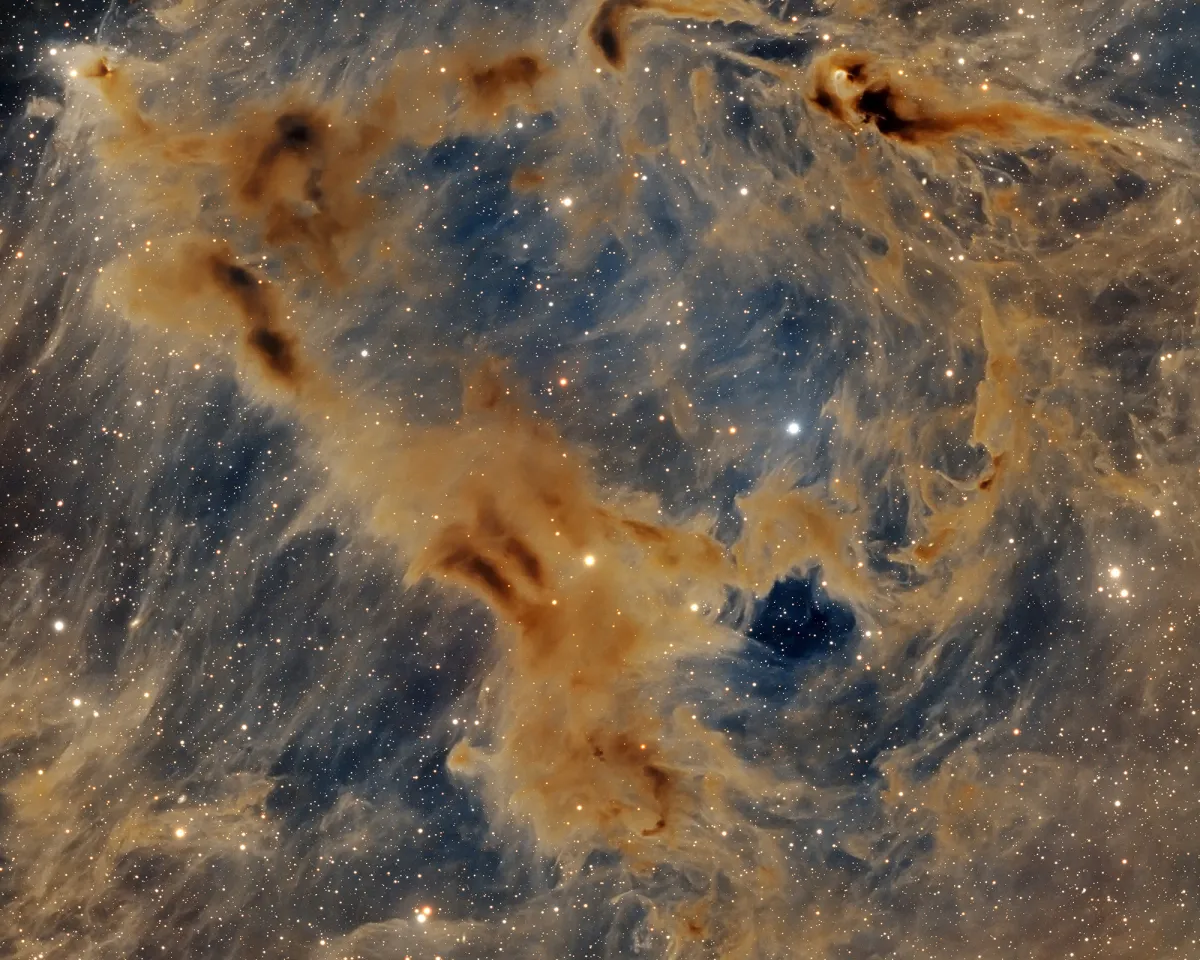Dark Scorpion Nebula (LDN 1147/1158)

History
In 1962 the American astronomer Beverly T. Lynds published a compilation of dark nebula in her «Catalogue of Dark Nebulae» that she found on the blue and red photo plates of the «National Geographic Palomar Observatory Sky Atlas» (POSS), taken with the 48 inch Oschin Schmidt telescope at Mount Palomar Observatory. Here she identified the dark nebulae LDN 1147, 1148, 1152, 1155, 1157 and 1158. [473] In her 1965 «Catalogue of Bright Nebulae» she listed a brighter parts of this molecular cloud as LBN 102.67+15.42 (LBN 468), measuring 60 x 50 arcminutes in size.[270]
In 1977 the two Armenian astronomers Armen Gyul'budaghian and Tigran Yu. Magakian discovered the small reflection nebula GM 3-12 on the red plates of the Palomar Observatory Sky Survey (POSS) taken in 1952 and verified it using the new 2.6 metre reflector at the Byurakan Astrophysical Observatory in Armenia. [723]
In 1980 Martin Cohen published his survey of «Red and nebulous objects in dark clouds» discovered on the POSS photo plates. There he listed the reflection nebula GM 3-12 as RNO 124 with the notes: «Cometary, very faint, very red star, ring nebula.» [724] The red star was later identified as infrared source IRAS 20359+6745 basend on the ten month survey mission of the Infrared Astronomical Satellite (IRAS) launched in 1983. [725]
The nicknames «Dark Scorpion Nebula» or «Black Scorpion Nebula» or just «Scorpion Nebula» is sometimes associated only to the dark nebula LDN 1152 and sometimes to the whole LDN 1147/1158 cloud complex. The name probably originates from the astrophotographic community as with enough imagination the whole complex looks a bit like a scorpion.

Physical Properties
LDN 1147/1158 is a filamentary molecular cloud complex hosting active star formation and various young stellar objects. The most remarkable of those is IRAS 20359+6745 which is the source of the of the cometary nebula GM 3-12 (RNO 124) and Herbig-Haro object HH 376A. The nebula is cone-shaped with the star IRAS 20359+6745 at the apex, straight walls and two probable helical arms. HH 376A is the bow shock structure in the collimated high velocity flow, directed by the axis of the cone nebula, with shock velocity about 70−80 km/s. [726] Based on Gaia DR2/EDR2 parallaxes the young stellar object IRAS 20359+6745 is in a distance of 337-345 pc. [145]
| Name | Type | RA (J2000.0) | Dec (J2000.0) | PM [mas/y] | Parall. [mas] | Size ['] | Magnitudes | Identifiers |
|---|---|---|---|---|---|---|---|---|
| IRAS 20359+6745 | Or* | 20h 36m 20s | +67° 56' 32" | 7.902 | 2.962 | 0.36 × 0.36 | V 17.81; G 16.054884; R 16.02; I 14.34; J 11.364; H 9.739; K 8.781 | 2MASS J20361986+6756316; GM 3-12; GN 20.35.9; Gaia DR2 2246967876695385728; Gaia DR3 2246967876695385728; HBC 695; IRAS 20359+6745; IRAS F20358+6746; LEDA 2708838; PSCz P20359+6745; RNO 124; SSTc2d J203619.8+675632; SSTgbs J2036198+675631; SSTgbs J2036198+6756316; TIC 422370023; [CM2009] 3; [K98c] Em* 6; [KWD2009] 3; [PWK2017] 5 |
| LBN 468 | HII | 20h 42m 00s | +67° 54' 00" | LBN 102.67+15.42; LBN 468 | ||||
| LDN 1147 | DNe | 20h 40m 32s | +67° 20' 42" | LDN 1147 | ||||
| LDN 1148 | DNe | 20h 40m 32s | +67° 21' 45" | JWT Cloud 420C; LDN 1148; MLB 3-61; TDS 379; [BM89] 1-99 | ||||
| LDN 1152 | DNe | 20h 35m 50s | +67° 54' 22" | LDN 1152; MLB 3-60; [BM89] 1-97 | ||||
| LDN 1155 | DNe | 20h 43m 30s | +67° 41' 00" | LDN 1155 | ||||
| LDN 1157 | DNe | 20h 39m 06s | +68° 02' 13" | LDN 1157 | ||||
| LDN 1158 | DNe | 20h 44m 30s | +67° 41' 00" | 20 × 20 | LDN 1158; [DB2002b] G102.66+15.17 |
Finder Chart
The dark nebula complex LDN 1147/1158 is located in constellation Draco at the border to Cepheus. Roughly two degrees to the east lies NGC 7023. The constellation is in opposition to the Sun on 30 July and then highest in the sky at local midnight.
